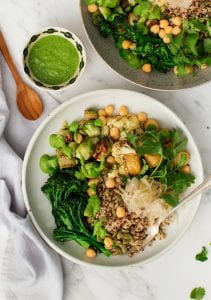The world has changed, seemingly overnight, bringing stress, anxiety, sleepless nights, and a feeling of no control. One thing you have some control over is choosing how you eat. During these times it is really important to try your hardest to eat healthy meals by having a combination of foods from all five food groups–vegetables, fruits, grains, lean protein, and dairy. This coupled with proper exercise and staying hydrated will help you feel your best. Now comes the challenge of meeting this need, whether reaching in the pantry or shopping, some food items are becoming hard to find. Here are some ideas for eating healthy and stretching the food budget while making meals with what you have.
If fresh fruits and vegetables are in short supply or you aren’t going to the store as often as you did before, try loading up on frozen and canned fruits and vegetables when you can shop. Frozen can be just as nutritious as fresh, often frozen within hours of being picked. Frozen fruits work well in muffins and smoothies. Frozen vegetables are easily used in soups, stews, or even stir-fry’s. Look for fruits canned in light syrup, fruit juice, or even coconut water and choose canned vegetables labeled “low” or “no salt”. You can amp up the health factor in meals by adding extra vegetables–fresh, frozen, or canned to pasta, pizza, omelets, or smoothies.
Are there leftover mashed potatoes from dinner? Use them to make potato pancakes. Mix together 2 cups of leftover mashed potatoes, 1-2 eggs, 1/4 cup flour, and seasonings of your choice. Other ingredients can also be added- chopped onion or other diced vegetables, crumbled bacon or diced ham, and or shredded cheese. Preheat a skillet on medium high with 2 tablespoons of shortening or vegetable oil. Pour 1/4 cup of batter for each pancake into the hot pan; brown on both sides. Serve with a side of applesauce or other fruit.
Looking for a fun flexible family-friendly meal? Experiment with making a grain bowl.
In individual bowls layer:
1/2 – 1 cup cooked grains: rice, quinoa, barley, or other favorite
1/2 cup cooked protein: cooked or leftover meat, fish, beans, eggs, or cheese
1- 1 1/2 cups vegetables: raw, steamed, roasted, sautéed, or pickled
1/4 cup fruit: diced or sliced, if using dried reduce to 2 tablespoons
Top with:
1-2 tablespoons of sauce – pesto, a balsamic reduction, or your favorite dressing
1 tablespoon of roasted nuts or seeds
Short of any ingredients just omit or use a substitute. Served hot or cold grain bowls come with enough variety to make everyone in the family happy.
Having trouble buying fresh meat? Try some beans- kidney, navy, pinto, black, lentils, and more. Beans are high in protein and fiber and are a great addition to any meal. To make them the star of the meal, make this recipe for Garbanzo Bean Burgers at http://cceschoharie-otsego.org/garbanzo-bean-burgers. You can change this recipe up just by using a different kind of bean, like black beans or black-eyed peas.
Make sure foods you are planning for meals do not get “snacked” away. Label foods in the cupboard, refrigerator, and freezer for their intended purpose. Have a designated spot for foods available for snacking both in and out of the refrigerator to help avoid an in house supply shortage.
Last but not least, try experimenting with foods you already have on hand and make something new. You might be surprised just how good it tastes! Challenges presented by tightened supply lines may make some of these ideas difficult to accomplish. Just remember ingenuity is key, so choose to make the most from what you have.
If you are interested in more of helpful tips, nutritional information, or classes, you can also contact
Michelle Leveski, Nutrition Program Educator by calling 518-234-4303 ext. 115 (please leave a message), or emailing her at mml39@cornell.edu


